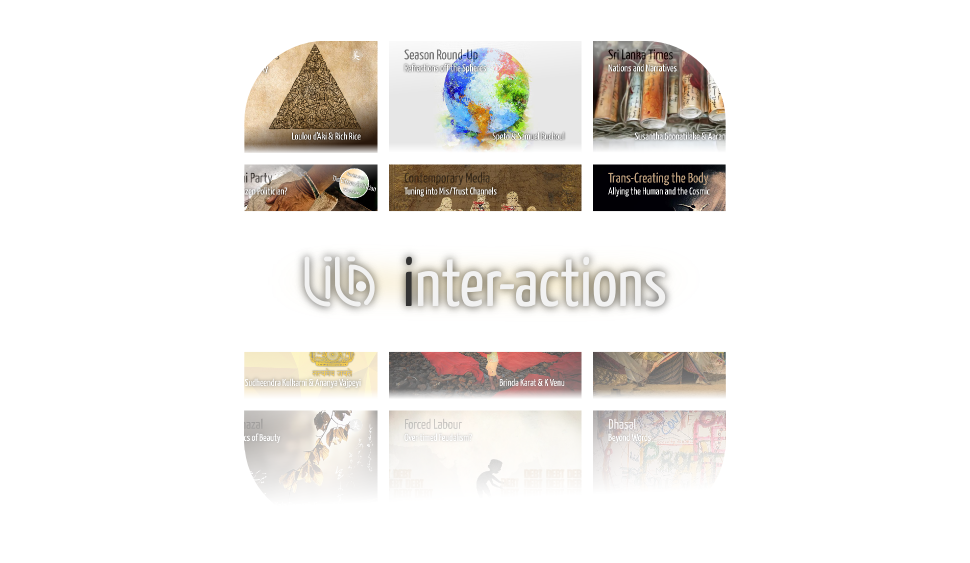

|
|
|
Ananthamurthy: Hearing the Here
|
|
Our Warring Moves: Space, Conflict, Beauty
|
| Nikhil Govind & N Nagaraju |
29 August 2014 |
|
Loulou d’Aki & Rich Rice |
22 August 2014 |
Where in the world could the question of language politics be more relevant than in India? Colonisation’s trail invited a project of unification with a character and a scale unseen for centuries. If customs, cuisine, activities or traditions would tend to be at odds across regions, it is naturally languages that would rise to the surface as the most pressing concern. Languages of politics and governance, of course, but also, and especially, languages of the imaginary, of the fantastic and the mundane: languages of communities drawing their avenir. Piloting the creative drives of the millions, writers have been assuming the delicate task of arbitrating the dynamics of cultures, between unscripted patois, regionalisms, state languages and national vernaculars. And all this, in the midst of literary currents and aspirations crossing borders and millennia. Last week, India gave a final homage to an unmistakable voice, to a wordsmith symbolising an affirmation of the here within the all: UR Ananthamurthy. In our dialogue this week, Nikhil Govind evokes personal memories to portray an author whose passionate outspokenness was only equal to the constancy of his intellectual patience and to the depth of his commitment as a social figure. N Nagaraju celebrates the questions left by Ananthamurthy’s generation, and exalts the ‘hospitality’ that bridges languages.  |
|
“I know not with what weapons World War III will be fought, but World War IV will be fought with sticks and stones.” Albert Einstein’s intuition seemed confirmed too fast, except perhaps for the fact that a third World War was not needed to bring back our nations to the raw forms of physical violence. Congo, Sudan, Ukraine, Colombia, Gaza, Iraq, Syria and Thailand are many proofs of the fall of the Western dream of technological positivism, and of the vectorisation of fundamental interdependent global tensions as far as possible from the sanctuaries of welfare states. Spatial considerations, indeed! In fact, the profusion of ongoing conflicts must, first, call for a radical rethinking of the metaphysics of space. It is because war is an intensification of spaces, today’s reality of war must be used to prepare a simultaneous reality of beauty. Such an attempt would show that beauty is what makes the three-dimensionality of space possible: observation, action, and design. Beauty is the fundamental event that assembles the three elementary agents along an equilateral space. On the occasion of its thirtieth publication, LILA Inter-actions acknowledges its transformed nature and redefines itself as an online medium of translocal dialogues. Along with those millions of actors, this week, LILA Inter-actions brings you, indeed, a witness and a proxy player. Photojournalist Loulou d’Aki ponders on the sustenance and the ethics of the beautiful, as the observing lens virtualises and distances the space of the events away from the photographer. New Media expert Rich Rice looks at strategies of ‘the constellation of squares’, at the aesthetics of the motions in chess, to reveal how war and beauty are the two natural guests of space.  |
|
|
|
Trans-Creating the Body: Allying the Human
and the Cosmic
|
|
The Promise of Gaza: Outstripping Confrontation
|
| Pushpamala N and Naman Ahuja |
15 August 2014 |
|
Sujata Ashwarya Cheema
& Ibrahim Abughali |
8 August 2014 |
At the horizon, the sun is still master of the skies, but, by the thousands, the green, white and orange lozenges come and break its rays. The man-made comes to affront nature; the human defies the cosmos. Somewhere, some time, much before this Friday evening, something happened and one species among so many would become self-conscious about a hither-to unstated feature of the experience of being in an environment: beauty. And somewhere, some other time, the human body was discovered as another possible locus for harmony and order. Beauty and the body: humanity’s foundational dilemma and gift, limitation and spiritual springboard. On this day of the 67th anniversary of Indian Independence, LILA Inter-actions asked two major faces of the arts in India today, to present the deep connections of body and the beautiful, in Indian aesthetics and in their personal practice. Photo and video performer Pushpamala N walks the memory lane to recount how she came to consider the very artist’s body as medium for the aesthetic, where beauty hides in performance, between humour, surprise and improvisation. Art critic and curator Naman Ahuja reflects on the complex relation of Indian art with images of divine and human bodies, from indispensable ritualistic media to insufficient material representations. At the crossroads: the mirror, edge of the beautiful, and intermediary for the experiencer, henceforth able to unite image and reality.  |
|
The world order was far from being deeply shaken, in November 2012, when the United Nations recognised Palestine as a non-member observer state. But, with the support of a large majority, the vote became the symbol of a turning historical point: a global, almost exhaustive and irrevocable recognition of Palestine’s right to self-determination. Alas, that would become an interstice of optimism, before the recurrence of attacks and their correlated resolute resistance. A wave of diplomatic and public activism has been pushing towards the peaceful ending of the decades-long fights, but the repeated interruptions of the cease-fires reveal how even an overall consensus struggles in bridging the gap between ideal principle and pragmatic compromise. Indeed, how can states and citizens partake in the actual making of the universal project of peace? If Gaza is the emblem of one global promise, it is this one: the world’s creative imagination to find alternative means of translating principles. This week, LILA Inter-actions invites Sujata Ashwarya Cheema, International Relations specialist, who carefully traces the history of India’s rapport with Israel, and the profound rhizomes that explain the positions of current governments. Computer Sciences researcher and native Palestinian Ibrahim Abughali reflects on the global dimension of the conflict via new technological possibilities, forming the means of strenuous subversions, against the backdrop of what remains the everyday reminder of the reign of force.  |
|
|
 |
Echoes of the Queer: Blurring the Frame
|
|
|
| Mavin Khoo and Pramada Menon |
1 August 2014 |
|
|
|
Where is the queer? Once a derogatory term for homosexuals, it became a subversion, accompanying the LGBT emancipation movements of the last half-century. But the queer remains on the run: contesting primarily heteronormativity in its early form, it widened its scope to address the very conception of fixed gender and sexual identities. The queer permits to transform artistic, cultural, intellectual, social and political experiences into ever changing, moving and ambiguous events. Thus, indeed: where is the queer? How to locate it without fixing it? How can an indefinite object be expressed and shared? If its raison d’être is the contestation of binaries, can we expect of queer movements to be the models of a transcended content/form opposition? What can the queer bring to the fields of communication and the arts? And, when the queer is discussed or represented, is this process of translation itself, inversely, redefining the queer? To start a new season at Inter-actions, we invited two major voices from the vast and multifaceted reality of today’s queer. Pramada Menon reflects on the object and technical choices of her 2013 documentary And You Thought You Knew Me, stepping away from the popular images of the queer movement. For Malaysian Bharat Natyam artiste Mavin Khoo, dance reveals a performative rediscovery of the queer, pushing it even beyond concerns of sexuality and gender.  |
|
 |
Disclaimer: The opinions expressed by the writers are their own. LILA Inter-actions will not be responsible for the views presented.
|
Spread the word…
|
|
|
|
|
|
… follow LILA!
|
|
|
|
|
|
|
|
Knowledge is power, and our intention is to bring the power to you. We have initiated a thought movement that aims to strengthen democracy by bringing to you direct voices of important trailblazers and pathmakers, and reclaim deep and patient reflection as an important seed for relevant and sustainable action!
Help us take this movement forward. Support Inter-Actions today for as little as Rs. 100. DonateDonation to LILA is eligible for tax exemption u/s 80 G (5) (VI) of the Income Tax Act 1961 vide order no. NQ CIT (E) 6139 DEL-LE25902-16032015 dated 16/03/2015


